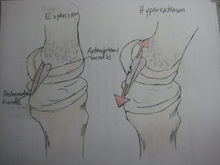Posterior cruciate ligament injury
| Posterior cruciate ligament injury | |
|---|---|
 | |
| Posterior cruciate ligament (center) | |
| Specialty | Orthopedic surgery |
The function of the posterior cruciate ligament (PCL) is to prevent the femur from sliding off the anterior edge of the tibia and to prevent the tibia from displacing posterior to the femur. Common causes of PCL injuries are direct blows to the flexed knee, such as the knee hitting the dashboard in a car accident or falling hard on the knee, both instances displacing the tibia posterior to the femur.[1]
Surgery to repair the posterior cruciate ligament is controversial due to its placement and technical difficulty.[2]
The posterior drawer test is one of the tests used by doctors and physiotherapists to detect injury to the PCL.
An additional test of posterior cruciate ligament injury is the posterior sag test, where, in contrast to the drawer test, no active force is applied. Rather, the person lies supine with the leg held by another person so that the hip is flexed to 90 degrees and the knee 90 degrees.
Patients who are suspected to have a posterior cruciate ligament injury should always be evaluated for other knee injuries that often occur in combination with an PCL injuries. These include cartilage/
Cause

Related anatomy
The PCL is located within the

Related physiological features
Although each PCL is a unified unit, they are described as separate anterolateral and posteromedial sections based on each section's attachment site and function.
The types of mechanisms that lead to PCL injury
In this position, the PCL functions to prevent movement of the tibia in the posterior direction
Diagnosis
This section is empty. You can help by adding to it. (December 2017) |
Prevention
Knee injury
Knee injuries are very common among athletes as well as regular active people and can always be prevented.
Quadriceps and hamstring ratio
Another important aspect of maintaining an injury free knee is having strong

Exercises and stretches
In addition, balancing exercises have also been adopted because it has been proven that people with poor balance have more knee injuries than those with good balance. Wobble boards and Bosu balls are very common pieces of equipment used to balance and help prevent knee injuries as long as they are being used with trained personnel.[20] Another possible preventive measure is wearing knee straps to help stabilize the knee and protect it from injury, especially during demanding sports such as football.[21]
Treatment
It is possible for the PCL to heal on its own. Surgery is usually required in complete tears of the ligament. Surgery usually takes place after a few weeks, in order to allow swelling to decrease and regular motion to return to the knee. A procedure called ligament reconstruction is used to replace the torn PCL with a new ligament, which is usually a graft taken from the hamstring or Achilles tendon from a host cadaver. An arthroscope allows a complete evaluation of the entire knee joint, including the knee cap (patella), the cartilage surfaces, the meniscus, the ligaments (ACL & PCL), and the joint lining. Then, the new ligament is attached to the bone of the thigh and lower leg with screws to hold it in place.[22] PCL repair can also be undertaken. This differs from PCL reconstruction because a graft is not needed and the native PCL is reattached.[23]
Rehabilitation
Grades of injury
The posterior cruciate ligament is located within the knee.
Rehabilitation options
It is possible for the PCL to heal on its own without surgery when it is in Grades I and II. PCL injuries that are diagnosed in these categories can have their recovery times reduced by performing certain rehabilitative exercises. Fernandez and Pugh(2012) found that following a PCL grade II diagnosis, a

Epidemiology
Percentage of PCL to other knee injuries
According to[27] the posterior cruciate ligament injuries only account for 1.5 percent of all knee injuries (figure 2). If it is a single injury to the posterior cruciate ligament that requires surgery only accounted for 1.1 percent compared to all other cruciate surgeries but when there was multiple injuries to the knee the posterior cruciate ligament accounted for 1.2 percent of injuries.
National statistics
In 2010 national statistics was done by Agency for Healthcare Research and Quality for posterior cruciate ligaments injuries. They found that 463 patients were discharge for having some type of PCL injury. The 18- to 44-year-old age group was found to have the highest injuries reported (figure 1). One reason why this age group consists of the majority of injuries to the PCL is because people are still very active in sports at this age. Men were also reported having more injuries to the PCL (figure 3).[citation needed]
Recommendation for surgery
A grade III PCL injury with more than 10mm posterior translation when the posterior drawer examination is performed may be treated surgically. Patients that do not improve stability during physical therapy or develop an increase in pain will be recommended for surgery.[28]
References
- ^ MedlinePlus Encyclopedia: Posterior cruciate ligament (PCL) injury
- ^ Jonathan Cluett, M.D. (2003-08-05). "Injuries to the posterior cruciate ligament (PCL)". about.com. Retrieved 2006-11-11.
- ^ Posterior Sag Test From The University of West Alabama, Athletic Training & Sports Medicine Center. Retrieved Feb 2011
- ISBN 0-7216-0013-1.
- S2CID 15246937.
- PMID 1126079.
- ^ PMID 23022245.
- PMID 17349472.
- ^ S2CID 3524402.
- ^ PMID 16360655.
- S2CID 42810072.
- PMID 8106532.
- S2CID 24386922.
- PMID 23181354.
- ^ S2CID 23746497.
- ^ ISBN 978-0-7817-9128-1.[page needed]
- S2CID 73260965.
- .
- PMID 23226553.
- S2CID 27442246.
- PMID 17698680.
- ^ http://www.orthspec.com/pdfs/PCL-injuries.pdf[full citation needed]
- PMID 31467838.
- ISBN 9783319120713
- PMID 23204951.
- S2CID 22150465.
- ^ Majewski et al.[full citation needed]
- ^ (Mariani teal., 2002)[full citation needed]
External links
- lljoints at The Anatomy Lesson by Wesley Norman (Georgetown University) (antkneejointopenflexed)
- Dealing with Torn Ligament in the Knee
- http://www.orthspec.com/pdfs/PCL-injuries.pdf
